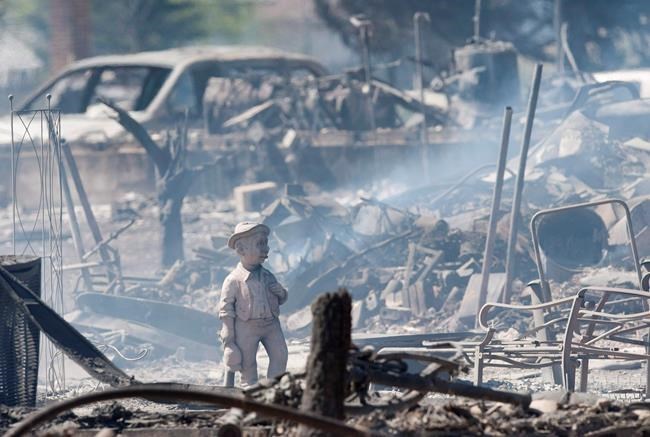
The smouldering remains of houses in Slave Lake, Alta., are seen in a May 16, 2011, file photo. The wildfire that is devastating large swaths of the northern Alberta city of Fort McMurray comes just five years after another blaze destroyed 400 buildings and left 2,000 people homeless in Slave Lake, Alberta. THE CANADIAN PRESS/Ian Jackson
Republished May 04, 2016 - 9:45 AM
Original Publication Date May 04, 2016 - 4:25 AM
As Tyler Warman raced north toward the fire that was consuming Fort McMurray, memories of the blaze that devastated his small community five years earlier came flooding back.
The mayor of Slave Lake and other crews headed to the northern oilsands city on Tuesday to help fight a fire that bore eerie similarities to one that reduced homes in Slave Lake to charred cement foundations and left entire neighbourhoods razed to ash.
Warman, who also fought the Slave Lake fire when it broke out on May 15, 2011, said the sight of Fort McMurray as he and the crew approached took him back to the long, punishing days of battling the blaze that destroyed 400 buildings and forced 7,000 people out of the community.
"We could see the flames from probably 35 kilometres out," he said about the drive into Fort McMurray. "We drove through fire to get here. A lot of people were evacuating, there was lots of smoke...There was lots of traffic moving in the other direction and it reminded me of our experience in 2011."
He said the devastation and evacuation were similar to what played out around Slave Lake, noting that they were trying to move 10,000 people out of his community rather than the 80,000 or so being evacuated from Fort McMurray.
Warman, who was in the fire department and a member of the Slave Lake council in 2011, said thick, black smoke filled the air in Fort McMurray as flames crept close to the roadways. He said he and others were heading out again Wednesday to help fight the fire after getting a couple of hours of sleep.
Lesser Slave River Reeve Murray Kerik, who also fought the Slave Lake fire, said he was heart sick when he turned on the TV and saw how a fire he had been monitoring for a couple of days in Fort McMurray had turned so dangerous, so quickly. He said it played out much like it did in Slave Lake, which had the added difficulty of flames that were whipped by 100-kilometre-an-hour winds.
"Watching it on TV, we could really feel for them because we've been there," he said from his home in Slave Lake. "It just makes my stomach turn. I've been there, I've seen this."
Kerik says he went three days without sleep while fighting the fire in Slave Lake.
On Tuesday, when he saw the flames inching closer to Fort McMurray, he immediately thought: "Here we go again."
In the end, some estimates pegged the damage in Slave Lake at up to $1 billion, which insurance adjusters estimated at the time made it the second-costliest disaster after the Quebec-Ontario ice storm of 1998. It was later determined that the an arsonist recklessly or deliberately ignited the forest fire that reduced a third of Slave Lake to rubble.
No civilians were hurt, but a fire-fighting helicopter pilot died after crashing on Lesser Slave Lake. About 1,400 firefighters along with 170 helicopters and tankers were deployed to Slave Lake, which is about 430 kilometres away from Fort McMurray.
A subsequent report into the disaster found Alberta's forest fire danger had grown to the point where it was beginning to outstrip the province's ability to respond. It said the fires moved faster than officials were able to communicate with each other or the people of Slave Lake. As a result, residents weren't told about how quickly the danger to themselves and their community was escalating.
Some residents complained that they were forced to turn back into the inferno when they tried to leave town because they found that roads had been closed.
Kerik says it's too soon to say what may be learned form the fire in Fort McMurray, but that it appears they did well to get people out of the city quickly. He said a fire smart program has helped educate residents about risks, particularly when it comes to removing timber from near their homes to reduce it as a fuel source.
He said part of the problem in Fort McMurray may be the presence of black spruce trees, which he described as a low-lying swamp tree that can get extremely hot and be quite flammable. Kerik said they have tried to remove much of it from around Slave Lake.
Asked what he would tell the residents of Fort McMurray, Kerik referred to a sign that went up in Slave Lake after the blaze that read, "God bless, we will rebuild."
"And they will rebuild, it's just a matter of sticking to it," he said.
Warman also said it's too early to say whether lessons from the Slave Lake incident apply to this latest disaster.
"There will be lots of lessons learned here and some of them will be ones that we'd experienced before and some will be new," he said.
"We just feel very fortunate that we are able to come up here and lend a hand and pay some of that back, but we also recognize there's a long road ahead and it will take a while to get Fort McMurray back on its feet."
Follow @alison_auld on Twitter
News from © The Canadian Press, 2016